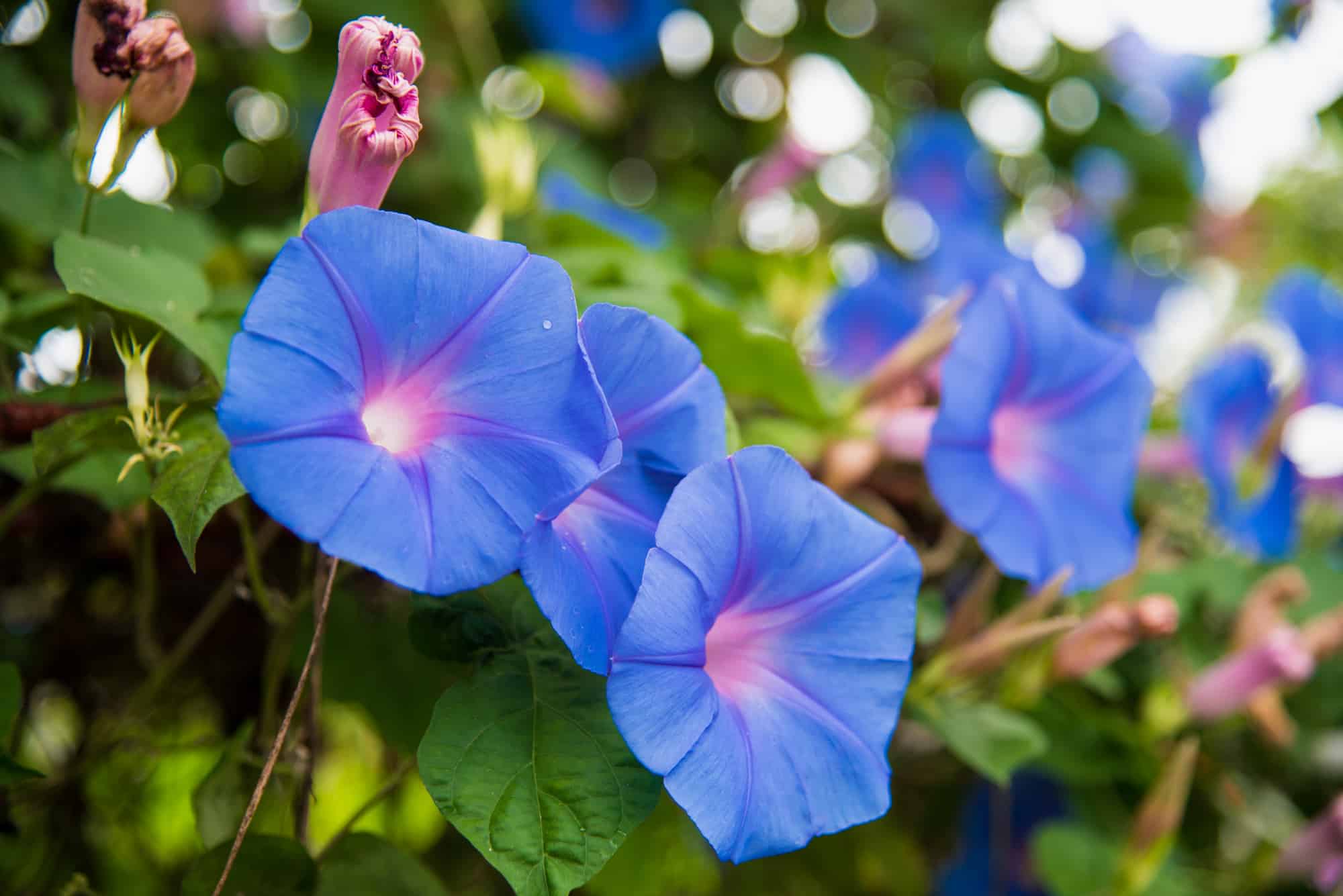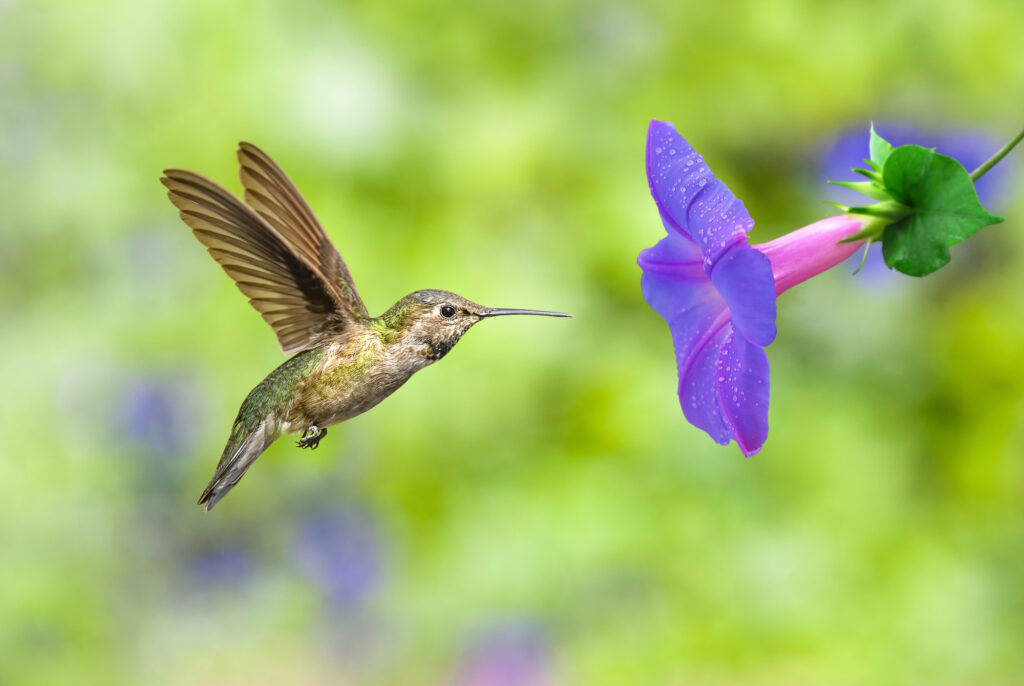Everyone knows that hummingbirds love bright, colorful flowers!
They’re also well known for flying backward, hovering in front of flowers and feeders, and beating their wings so fast that their wings are almost invisible.
But what types of flowers do hummingbirds prefer? Well, one flower that attracts these tiny birds is the morning glory!
Morning glories produce an abundance of sugary nectar that provides the high-energy food hummingbirds need to power their metabolism. The tubular shape of a morning glory bloom is perfectly designed to accommodate the long, slender beaks of hummingbirds.
But do hummingbirds actively seek out morning glories? Or are they more attracted to other flowering plants? This article will explore the connection between hummingbirds and morning glories.
What Are Morning Glories, Anyway?

Morning glories are annual vining plants that produce colorful trumpet-shaped flowers that open wide in the morning sunlight. There are over 1,000 species of morning glories, with popular garden varieties including Heavenly Blue, Grandpa Otts, Scarlett O’Hara, Flying Saucers, and Moonflower.
Morning glories grow quickly and vigorously, readily climbing trellises, fences, and arbors up to 6-10 feet tall. Their heart-shaped leaves provide good ground cover as the vines spread widely. Morning glories thrive in full sun and moist, well-drained soil.
The flowers bloom from early summer through frost, providing months of color and nectar for pollinators like hummingbirds.
Why Do Hummingbirds Like Morning Glories?
A hummingbird has a very fast metabolism and must consume up to half their body weight in nectar each day, spread out over multiple feedings. They will visit between 1,000 and 2,000 flowers every single day!
Morning glories produce an abundance of sugary nectar that helps satisfy a hummingbird’s extreme nutritional needs. Hummingbirds can lick between 15-20 times per second with their long tongues. The tubular trumpet shape of the morning glory flower is perfectly designed to accommodate hummingbirds’ long, slender bills!
As prolific bloomers, morning glories provide a constant renewable food source for hummingbirds through the growing season. The nectar content is ideally suited to hummingbird digestion and energy needs.
Do Other Pollinators Like Morning Glories?
Yes, morning glories attract a wide range of pollinators in addition to hummingbirds. Butterflies, skippers, bees, wasps, and hawk moths are also drawn to the nectar-rich tubular flowers.
Pollinators that cannot fit inside the flower openings still visit the flowers for nectar droplets and pollen on the exterior.
The diversity of pollinators, from tiny bees to large hawk moths, ensures good pollination and seed production for the morning glories to propagate future generations.
How To Grow Morning Glories
Morning glories are easy to grow from seed! Here are some tips for successfully cultivating these hummingbird-attracting plants:
- Site Selection: Choose a planting area that receives full sun for at least 6-8 hours per day. Morning glories thrive when given ample sunlight. Select a site with moist, well-draining soil. Amend the soil by mixing in 2-3 inches of compost or well-aged manure prior to planting.
- Planting: Sow morning glory seeds 1/2 inch deep either directly in the garden after the last frost date for your area or you can start them indoors 4-6 weeks before the last frost. Soaking seeds in warm water overnight before planting will soften the hard outer shell and improve germination rates. Sprouts will emerge in 5-21 days.
- Care & Growth: Once seedlings appear, thin to 4-6 inches apart. Provide a trellis, fence, or other climbing support structure for the vines to grow upwards. Morning glories can reach heights of 10-15 feet when given adequate support. Water plants regularly about 1 inch per week, and mulch around the base to retain moisture while plants establish. Fertilize with an organic bloom booster or low nitrogen fertilizer every 4-5 weeks during the active growing season.
- Bloom Period: Flowers start blooming in late summer and continue into fall until first frost. The blooms open in the morning and come in a vibrant range of colors like purple, blue, pink, red, and white. Expect prolific flowering during peak season.
- Self-Seeding: Morning glories readily self-seed, so you’ll likely see new seedlings emerge near the original vines each spring. Gently thin volunteer seedlings to 4-6 inches apart if desired.
In temperate climates, morning glories can be grown as annuals and replanted each year. In tropical and subtropical regions, they may return as perennials. Provide winter mulch in cold areas for better overwintering.
What Else Do Hummingbirds Like?
You’ll notice that hummingbirds often visit morning glories, but they certainly don’t limit themselves to the brightly colored morning glory blooms. The flowers they visit are determined by where they live. In the US, you can find them visiting these flowers, based on geographical region:
| Pacific Northwest: | Fuchsia Penstemon Columbine Lavender Sage Lilies Honeysuckle Rhododendrons Azaleas |
| Southwest: | Ocotillo Agave Penstemon Fairy Duster Desert Willow Sages Paintbrush Firecracker Plant Salvia |
| Great Plains: | Indian paintbrush Firecracker penstemon Yucca Columbine Trumpet vine Coralberry Bee balm Petunias Verbena Salvia |
| Midwest: | Cardinal flower Trumpet vine Bee balm Sage Columbine Petunias Daylilies Phlox Verbena Butterfly weed |
| Southeast: | Coral Honeysuckle Crossvine Trumpet Vine Petunias Bee Balm Butterfly Weed Cardinal Flower Impatiens Columbine |
| Northeast: | Bee Balm Cardinal Flower Trumpet Honeysuckle Hostas Daylilies Sages Columbine Petunias Phlox |
Advice for Attracting Hummingbirds With Morning Glories

To draw more hummingbirds to your yard or garden, one of your first steps should be to incorporate more morning glories and other tubular flowers that provide nectar.
Here are some tips to get started!
Start by planting morning glories on trellises, fences, and arbors where you can enjoy watching the hummingbird activity up close.
You will want to choose a mix of morning glory varieties to extend the blooming season. Ideally, you will plant patches of other flowers like petunias, bee balm, and coral honeysuckle which will attract hummingbirds.
Provide a water feature like a mister or fountain for bathing and drinking. Avoid pesticides that could impact hummingbird food sources. Keep feeders clean, change the nectar regularly, and use only white granulated sugar for homemade nectar.
In addition, pay attention to the information from our list in the previous section about what to grow in each geographic region in the US!
Tips for Using Hummingbird Feeders
What about feeders? Are they a good way to bring hummingbirds to your yard or garden?
Think of hummingbird feeders as a supplement to a hummingbird’s natural flower- and insect-based diet. It’s also a great technique for attracting hummingbirds to your yard.
Here are some tips for success with feeders.
We recommend that you select a feeder with perches and raised feeding ports suited to hummingbird beaks and tongues. You can purchase nectar or make your own at a 4:1 ratio of water to granulated sugar.
Ideally, you will change the nectar every 2-3 days, or even more frequently in very hot weather. This is to prevent bacterial growth at the feeders.
Clean your feeders thoroughly before refilling, and rinse with a water-vinegar solution periodically.
You should place the feeders in shady spots, which helps the nectar last longer.
Enjoy Your Morning Glories and Hummingbird Visitors!
By planting plenty of morning glories on climbing structures and incorporating other tubular flowers in your garden landscape, you can easily attract beautiful hummingbirds to your yard.
Watching them hover and feed at the blossoms, seeing their iridescent throat feathers flash in the sunlight, and hearing the whir of their rapid wing beats are rewarding experiences.
With the proper flowers and feeders, you’ll be delighted by these energetic tiny visitors drawn to your morning glories!


